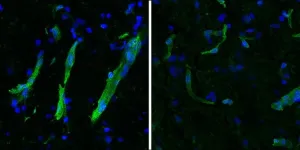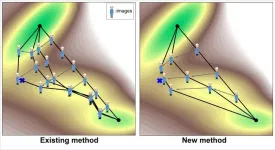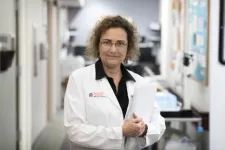(Press-News.org) CNIO researchers provide a new hypothesis to understand the origin of amyotrophic lateral sclerosis, or ALS. It would be triggered by a similar problem to that occurring in a group of rare diseases called ribosomopathies.
In ALS patients, motor neurons would accumulate an excess of non-functional ribosomal proteins that eventually collapse the cell's clearance systems and cause toxicity.
The study also opens a new front in aging research. The authors provide experimental evidence that formally proves a kind of stress called ‘nucleolar stress’ cause aging in mammals.
Amyotrophic lateral sclerosis (ALS) is a degenerative disease. The neurons responsible for movement begin to die and muscle control is progressively lost, leading to a fatal outcome. The causes of ALS are currently unknown, and there is no effective treatment.
In a paper published in Molecular Cell, a team led by Óscar Fernández-Capetillo, head of the Genomic Instability Group at the Spanish National Cancer Research Center (CNIO), provides the first evidence that a possible cause of the hereditary type of ALS –familial ALS– is the accumulation in motor neurons of 'junk proteins', proteins with no function that wrongly accumulate and prevent the cell from functioning properly.
Specifically, these non-functional proteins that accumulate are ribosomal proteins, which normally form ribosomes, molecular factories in charge of protein production.
Thus, this study provides a new hypothesis for understanding the origin of ALS, by suggesting that it has a similar origin to another group of rare diseases known as ribosomopathies, also associated with an excess of non-functional ribosomal proteins (in the case of ALS, this problem is restricted to motor neurons).
The new study also opens a new front in a different area, aging research. The authors propose a new causal factor in the aging process, which until now would have been overlooked: nucleolar stress, a mechanism by which organelles called nucleoli react to various damages in the cell.
"In our work we report a new model that explains how nucleolar stress induces toxicity in animal cells, and we provide direct evidence that it accelerates aging in mammals," Vanesa Lafarga, corresponding co-author of the study says.
A 'tar' that blocks RNA
Most patients with hereditary ALS share mutations in a gene called C9ORF72. This mutation results in the production of toxic proteins –or peptides– rich in the amino acid arginine. In a previous work, Fernandez Capetillo's group took the first steps to understand why these peptides are toxic. The reason is that these toxins stick to DNA and RNA "as if they were tar," affecting virtually all reactions in the cell that use these nucleic acids.
The study now published in Molecular Cell, with Oleksandra Sirozh as first author, shows that the toxin has a particularly acute effect on the manufacture of new ribosomes, production factories inside the cell, which are made up of RNA and proteins.
ALS as a ribosomopathy
Thus, as they are unable to complete their assembly, "the cell accumulates an excess of orphan ribosomal proteins, incapable of forming ribosomes," explains Fernández Capetillo. "These proteins end up collapsing the cellular clearance systems, which finally leads to the death of the motor neurons".
For the authors, this work suggests for the first time a similarity between the cause of ALS and another type of diseases known as ribosomopathies, also associated with the accumulation of dysfunctional ribosomal proteins in a generalized manner in all cells of the human body.
Potential treatment pathway
Based on this finding, the CNIO group has explored a solution. "As the problem is the excess of ribosomal junk, we explored strategies to make cells produce fewer ribosomes," explains Fernández-Capetillo. To achieve this, they used genetic and pharmacological manipulation to switch off two of the mechanisms that generate ribosomes in tissues in vitro, and found that, by producing less "garbage", toxicity is actually reduced.
However, Fernández-Capetillo says that these results should be interpreted with caution: "We are in the first steps to see if we can give a therapeutic angle to these findings”. For the moment, these experiments simply indicate "the possible existence of avenues that had not been explored in the search for treatments" against ALS. "We must find ways to reduce the production of ribosomes so that waste decreases, while still keeping a sufficient number to guarantee the correct functioning of the cells."
A new cause of aging: nucleolar stress
The nucleolus is the cellular component where ribosomes are synthesized. In recent decades it has been observed that one of its functions is also to detect stress situations in the cell, such as DNA damage or lack of nutrients. Nucleolar stress can eventually alter protein production, and its triggers are the object of a very active area of research.
In the work now published in Molecular Cell, the authors generated animals expressing throughout the body the toxin found in ALS patients, which induced severe nucleolar stress. But the researchers also observed, unexpectedly, that these animals aged very rapidly.
Junk proteins accelerate aging
Based on their previous studies, they found that this aging was also due to the accumulation of non-functional ribosomal proteins: when animals were given a drug that reduces the rate of ribosome production, their life expectancy doubled.
There had been speculation about the relationship between nucleolar stress and aging, but it had not been possible to demonstrate a causal relationship. This work "is the first experimental evidence that generating nucleolar stress accelerates aging," says Fernández Capetillo.
The work has been co-financed by the Ministry of Science, Innovation and Universities, FEDER funds from the European Union, the Spanish Association Against Cancer and the "la Caixa" Foundation in alliance with the Francisco Luzón Foundation.
END
On the surface, the movement disorder amyotrophic lateral sclerosis (ALS), also known as Lou Gehrig’s disease, and the cognitive disorder frontotemporal lobar degeneration (FTLD), which underlies frontotemporal dementia, manifest in very different ways. In addition, they are known to primarily affect very different regions of the brain.
However, doctors and scientists have noted several similarities over the years, and a new study in Cell reveals that the diseases have remarkable overlaps at the cellular and molecular levels, revealing potential targets that could yield therapies applicable ...
About The Study: In this study of 5,437 U.S. adults with health care visits in 2022, many patients, including those with the greatest care needs, chose telemedicine even after in-person visits were available. These findings support continuing this care delivery approach as an option valued by patients. Differences were not observed by most common measures of socioeconomic status. Continued monitoring of telemedicine use is needed to ensure equitable access to health care innovations.
Authors: Eva ...
About The Study: The results of this study of Medicare enrollees suggest that although nationally, Black and Hispanic individuals and individuals of other racial groups received more telemedicine visits during the pandemic and disproportionately lived in geographic regions with higher telemedicine use, after controlling for geographic region, Black and Hispanic individuals and individuals of other racial groups received fewer telemedicine visits than white individuals.
Authors: Felippe O. Marcondes, M.D., M.P.H., of Massachusetts General ...
More than half of all new doctors face some form of sexual harassment in their first year on the job, including nearly three-quarters of all new female doctors and a third of males, a new study finds.
That’s actually down somewhat from the percentage of new doctors who experienced the same five or six years before, according to the paper published in JAMA Health Forum by a team from the University of Michigan Medical School and Medical University of South Carolina.
And today’s ...
Academics are proposing a new and improved way to help researchers discover when consciousness emerges in human infancy.
When over the course of development do humans become conscious? When the seventeenth-century French philosopher René Descartes was asked about infant consciousness by his critics, he eventually suggested that infants might have thoughts, albeit ones that are simpler than those of adults. Hundreds of years later, the issue of when human beings become conscious is a question which remains a challenge for psychologists and philosophers alike.
But now, in response to a recent ...
A computational method for finding transition states in chemical reactions, greatly reducing computational costs with high reliability, has been devised. Compared to the most widely used existing method, the present method reduces the total computational cost by approximately 50 to 70%. The development, available on GitHub, is poised to accelerate advancements in material science, making the exploration of chemical reactions more accessible and efficient. This could lead to faster scientific discoveries and technological innovations.
In chemical reactions, substances ...
There were multiple unsafe sleep practices at play in more than three-quarters of Sudden Unexpected Infant Deaths reported in 23 jurisdictions between 2011 and 2020, a new study reveals. The researchers say the findings underscore the need for more comprehensive safe-sleep education for new parents, including from healthcare providers.
Of 7,595 infant deaths reviewed, almost 60% of the infants were sharing a sleep surface, such as a bed, when they died. This practice is strongly discouraged by sleep experts, who warn that a parent or other bed partner could unintentionally ...
HOUSTON ― The Institute for Data Science in Oncology (IDSO) at The University of Texas MD Anderson Cancer Center today announced the appointment of its inaugural cohort of IDSO Affiliates. These 33 talented scientists, clinicians and staff bring diverse expertise to help IDSO leadership and focus area co-leads advance collaborative data science projects and align the institute’s efforts with MD Anderson’s mission to end cancer.
“We are proud to welcome these exceptional individuals to the growing IDSO community, and we look forward ...
Toughening has always been an important research direction of structure ceramics. The addition of secondary phases to the ceramic matrix to prepare composite ceramics is an effective toughening pathway in the field of structure ceramics. Both phase-type and microstructure of the secondary phases play a decisive role in the toughening effect of the ceramic matrix. Being different from the conventional independent phase as the secondary phase, B4C@TiB2 core–shell structural unit has been purposely designed as an innovative kind of secondary phase to toughen the Al2O3 ceramic matrix, providing a new concept for the toughening studies of structural ceramics.
A ...
Messenger RNA (mRNA) made its big leap into the public limelight during the pandemic, thanks to its cornerstone role in several COVID-19 vaccines. But mRNAs, which are genetic sequences that instruct the body to produce proteins, are also being developed as a new class of drugs. For mRNAs to have broad therapeutic uses, however, the molecules will need to last longer in the body than those that make up the COVID vaccines.
Researchers from the Broad Institute of MIT and Harvard and MIT have engineered a ...





